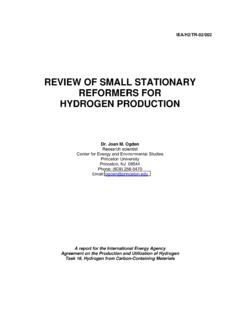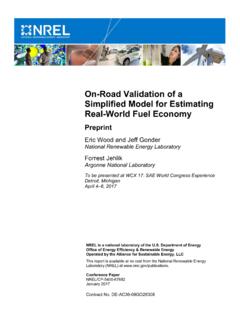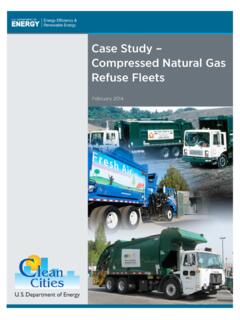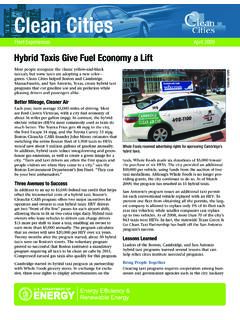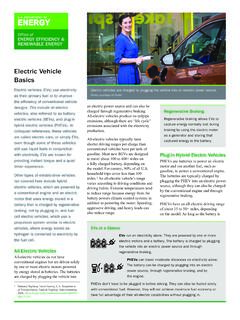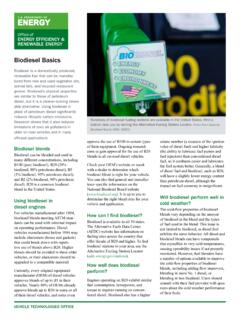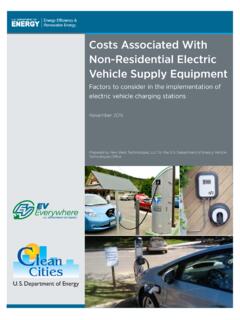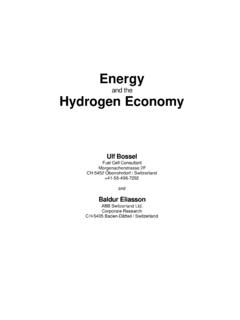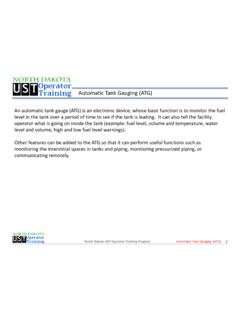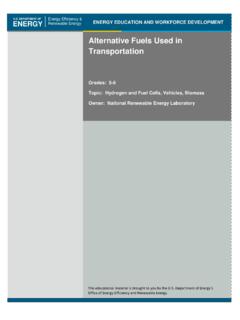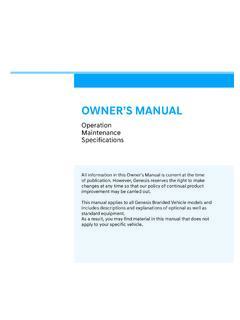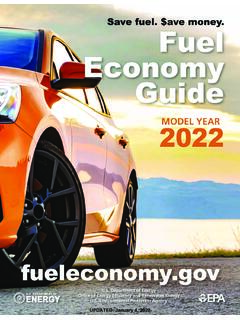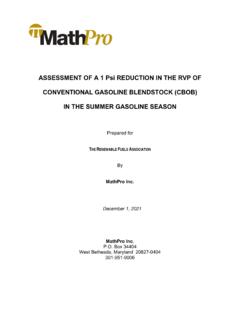Transcription of Alternative Fuels Data Center Fuel Properties Comparison
1 Alternative Fuels Data Center fuel Properties Comparison gasoline /E10 Low Sulfur Diesel Biodiesel Propane (LPG) Compressed Natural Gas (CNG) Liquefied Natural Gas (LNG) ethanol /E100 Methanol Hydrogen Electricity Chemical Structure [1] C4 to C12 and ethanol to 10% C8 to C25 Methyl esters of C12 to C22 fatty acids C3H8 (majority) and C4H10 (minority) CH4 (majority), C2H6 and inert gases CH4 same as CNG with inert gasses < (a) CH3CH2OH CH3OH H2 N/A fuel Material (feedstocks) Crude Oil Crude Oil Fats and oils from sources such as soybeans, waste cooking oil, animal fats, and rapeseed A by -product of petroleum refining or natural gas processing Underground reserves and renewable biogas Underground reserves and renewable biogas Corn, grains, or agricultural waste (cellulose) Natural gas, coal, or woody biomass Natural gas, methanol, and electrolysis of water Natural gas, coal, nuclear, wind, hydro, solar, and small percentages of geothermal and biomass gasoline or Diesel Gallon Equivalent (GGE or DGE) 1 gal = GGE 1 gal = DGE 1 gal = GGE 1 gal = DGE B100 1 gal = GGE 1 gal = DGE B20 1 gal = GGE 1 gal = DGE 1 gal = GGE 1 gal = DGE 1 lb.
2 = GGE 1 lb. = DGE 1 lb. = GGE 1 lb. = DGE 1 gal = GGE 1 gal = DGE 1 gal = GGE 1 gal = DGE 1 lb. = GGE 1 l b. = DGE 1 kg = 1 GGE 1 kg = DGE 1 kWh = GGE 1 kWh = DGE Energy Comparison [2] 1 gallon of gasoline has 97% 100% of the energy in 1 GGE. Standard fuel is 90% gasoline , 10% ethanol . 1 gallon of diesel has 113% of the energy in 1 GGE due to the higher energy density of diesel fuel . 1 gallon of B100 has 93% of the energy in 1 DGE, and 1 gallon of B20 has 99% of the energy in 1 DGE due to a lower energy density in biodiesel. 1 gallon of propane has 73% of the energy in 1 GGE due to the lower energy density of propane. lb., or ft3, of CNG has the same energy as 1 GGE, and lb., or ft3, of CNG has the same energy as 1 DGE. [3 ][4 ](b) lb. of LNG has the same energy as 1 GGE, and lb.
3 Of LNG has the same energy as 1 DGE. (a) 1 gallon of E85 contains 73% 83% of the energy in 1 GGE. 1 gallon of E100 has 67% of the energy in 1 GGE. ethanol is blended with blendstock for oxygenate blending ( gasoline component). [5] 1 gallon of methanol contains 50% of the energy as 1 GGE. lbs. (1 kg) of H2 has the same energy as 1 GGE. A typical battery that is the same size as a gallon of gas ( ft3), when used for transportation, can store of the energy in 1 GGE. [6][7] Energy Content (lower heating value) 112,114 116,090 Btu/gal (c) 128,488 Btu/gal (c) B100 119,550 Btu/gal B20 126,700 Btu/gal (c) 84,250 Btu/gal (c) 20,160 Btu/lb [3 ](b) 21,240 Btu/lb (a) 76,330 Btu/gal for E100 (c) 57,250 Btu/gal (c) 51,585 Btu/lb (c) kWh/kg 3,414 Btu/kWh Energy Content (higher heating value) 120,388 124,340 Btu/gal (c) 138,490 Btu/gal (c) 127,960 Btu/gal for B100 (c) 91,420 Btu/gal (c) 22,453 Btu/lb [1](c) 23,726 Btu/lb (c) 84,530 Btu/gal for E100 (c) 65,200 Btu/gal (c) 61,013 Btu/lb (c) 3,414 Btu/kWh Alternative Fuels Data Center fuel Properties Comparison gasoline /E10 Low Sulfur Diesel Biodiesel Propane (LPG) Compressed Natural Gas (CNG) Liquefied Natural Gas (LNG)
4 ethanol /E100 Methanol Hydrogen Electricity Physical State Liquid Liquid Liquid Pressurized liquid (heavier than air as a gas) Compressed gas (lighter than air) Cryogenic liquid (lighter than air as a gas) Liquid Liquid Compressed gas (lighter than air) or liquid Electricity Cetane Number N/A 40 55 ( d) 48 65 ( d) N/A N/A N/A 0 54 ( e) N/A N/A N/A Pump Octane Number 84 93 ( f) N/A N/A 105 (g) 120+ (h) 120+ (h) 110 (i) 112 (i) 130+ (g) N/A Flash Point -45 F ( j)165 F ( j) 212 to 338 F ( d) -100 to -150 F (j) -300 F (j)-306 F ( k)55 F ( j) 52 F ( j) N/A N/A Autoignition Temperature 495 F ( j) ~600 F ( j) ~300 F ( d) 850 to 950 F ( j) 1,004 F (j) 1,004 F ( k) 793 F ( j) 897 F ( j) 1,050 to 1,080 F ( j) N/A Maintenance Issues Lubricity is improved over that of conventional low sulfur diesel fuel .
5 For more maintenance information see, the Biodiesel Handling and Use Guidelines Fifth Edition. (d)High-pressure tanks require periodic inspection and certification. LNG is stored in cryogenic tanks with a specific hold time before the pressure build is relieved. The vehicle should be operated on a schedule to maintain a lower pressure in the tank. Special lubricants may be required. Practices are very similar, if not identical, to those for conventionally fueled operations. Special lubricants must be used as directed by the supplier as well as M85-c ompatiblereplacement parts. Can cause serious damage to organs in the body if a person swallows it, breathes it in, or gets it on their skin. When hydrogen is used in fuel cell applications, maintenance should be very minimal. High-pressure tanks require periodic inspection and certification.
6 Energy Security Impacts Manufactured using oil. Transportation accounts for approximately 30% of total energy needs and 70% of petroleum consumption. (l) Manufactured using oil. Transportation accounts for approximately 30% of total energy needs and 70% of petroleum consumption. (l) Biodiesel is domestically produced, renewable, and reduces petroleum use 95% throughout its lifecycle. (m) Approximately half of LPG is derived from oil, but no oil is imported specifically for LPG production. CNG is domestically produced from natural gas and renewable biogas. The United States has vast natural gas reserves. LNG is domestically produced from natural gas and renewable biogas. The United States has vast natural gas reserves. ethanol is produced domestically. E85 reduces lifecycle petroleum use by 70%, and E10 reduces petroleum use by (n) Methanol is domestically produced, sometimes from renewable resources.
7 Hydrogen is produced domestically and can be produced from renewable sources. Electricity is produced domestically from a wide range of sources, including through coal-fired power plants and renewable sources, making it a versatile fuel . Alternative Fuels Data Center fuel Properties Comparison January 2021 DOE/GO-102021-5498 [1]Standard chemical formulas represent idealized Fuels . Some table values are expressed in ranges to represent typical fuel variations that are encountered in the field.[2]GGE table values reflect Btu range for common gasoline baseline references (E0, E10, and indolene certification fuel ).[3] The type of meter or dispensing equipment being used to fuel vehicles must be taken into consideration. For fast-fill stations that dispense CNG with Coriolis flow meters, which measure fuel mass and report fuel dispensed on a "gallon of gasoline -equivalent" (GGE) basis, the factor should be used.
8 For time-fill stations or other applications that use traditional residential and commercial gas meters that measure/register in units of cubic feet, the CF/GGE factor should be used. [4]See Compressed Natural Gas in gasoline and Diesel Gallon Equivalency Methodology at [5] E85 is a high-level gasoline - ethanol blend containing 51% to 83% ethanol , depending on geography and season. ethanol content is lower in the winter months in cold climates to ensure a vehicle on composition, E85 s lower heating value varies from 83,950 to 95,450 Btu/gal. [6]Lithium-ion battery density of 400 Wh/l from Linden and Reddy, Handbook of Batteries, 3rd ed., McGraw-Hill, New York, 2002.[7]Lithium-ion energy densities increased by a factor of , when used for transportation, to account for the increased efficiencies of electric vehicle drivetrains relative to the internal combustion engine.
9 Sources (a)NIST Handbook 44 Mass Flow Meters Appendix E (b)Report of the 78th National Conference on Weights and Measures. 1993. NIST Special Publication 854, pp 322 326. (c)Greenhouse Gases, Regulated Emissions, and Energy Use in Transportation (GREET) Model. 2019. Input fuel Specifications. Argonne National Laboratory. Chicago, IL. (d)T. A lleman, McCormick, Christensen, G. Fioroni, K. Moriarty, and J. Yanowitz. 2016. Biodiesel Handling and Use Guidelines Fifth Edition, National Renewable Energy Laboratory (NREL). (e)American Petroleum Institute (API). 2011. Alcohols and Ethers. Publication No. 4261, 3rd ed. (Washington, DC, June 2001), Table 2.(f)Petroleum Product Surveys: Motor gasoline . Summer 1986. Winter 1986/1987. National Institute for Petroleum and Energy Research.
10 (g)American Petroleum Institute (API). 2001. Alcohols and Ethers. Publication No. 4261, 3rd ed. (Washington, DC, June 2001), Table B-1 .(h)K. Owen and T. Coley. 1995. Automotive Fuels Reference Book: Second Edition. Society of Automotive Engineers, Inc. Warrendale, PA. (i)J. Heywood. 1988. Internal Combustion Engine Fundamentals. McGraw-Hill Inc. New York.(j)Methanol Institute. fuel Properties . Accessed 11/14/2012 at (k)M. Foss. 2012. LNG Safety and Security. Bureau of E conomic Geology, Jackson School of G eosciences. University of Texas at Austin.(l)Energy Information Administration. Use of Energy Explained: Energy use for transportation. (m) J. Sheehan, V. Camobreco, J. Duffield, M. Graboski, and H. Shapouri. 1998. An Overview of Biodiesel and Petroleum Diesel Life Cycles.
